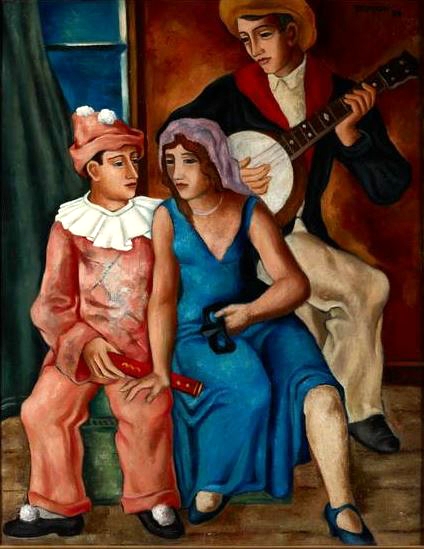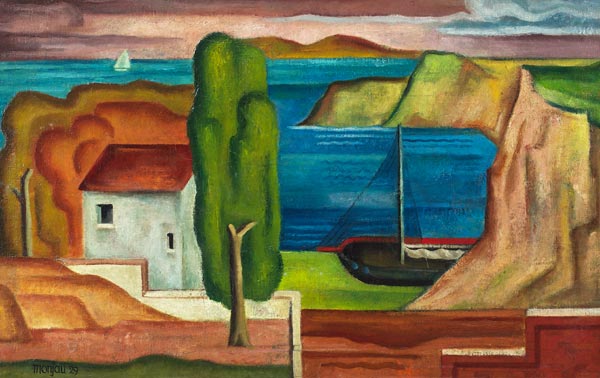Franz Monjau on:
[Wikipedia]
[Google]
[Amazon]
 Franz Monjau (30 January 1903,
Franz Monjau (30 January 1903,
 As a free-lance painter, he became a member of
As a free-lance painter, he became a member of  From 1936 to 1938, he was a drawing teacher at a private "Jüdischen Volksschule" (Jewish People's School) in Düsseldorf. He also made a few painting trips to the
From 1936 to 1938, he was a drawing teacher at a private "Jüdischen Volksschule" (Jewish People's School) in Düsseldorf. He also made a few painting trips to the Leopoldstraße 22: Monjau, Franz, Kunstmaler; Monjou-Mertens, Mieke (Anmerkung: leicht geänderter Name, Tippfehler?), Gymnastiklehrerin, 3. Etage
in Adressbuch der Stadt Düsseldorf, 1940, S. 295 Finally, in 1944, he was denounced by a co-worker for not responding to a "Heil Hitler". He was arrested and taken to the local

Franz Monjau
auf Gedenkstätte Buchenwald, retrieved 1 October 2017
Franz Monjau (engl.)
United States Holocaust Memorial Museum, Washington, DC
Während des Nationalsozialismus (1933–1945) verfolgte und zu Tode gekommene Kunstschaffende: Franz Monjau (PDF)
auf Verein memoriart33-45, Bern {{DEFAULTSORT:Monjau, Franz 1903 births 1945 deaths 20th-century German painters 20th-century German male artists German Expressionist painters German people who died in Buchenwald concentration camp Artists from Cologne
 Franz Monjau (30 January 1903,
Franz Monjau (30 January 1903, Cologne
Cologne ( ; german: Köln ; ksh, Kölle ) is the largest city of the German western States of Germany, state of North Rhine-Westphalia (NRW) and the List of cities in Germany by population, fourth-most populous city of Germany with 1.1 m ...
- 28 February 1945, KZ Buchenwald
Buchenwald (; literally 'beech forest') was a Nazi concentration camp established on hill near Weimar, Germany, in July 1937. It was one of the first and the largest of the concentration camps within Germany's 1937 borders. Many actual or sus ...
) was a German Expressionist
Expressionism is a modernist movement, initially in poetry and painting, originating in Northern Europe around the beginning of the 20th century. Its typical trait is to present the world solely from a subjective perspective, distorting it rad ...
painter and art teacher.
Biography
His father, Max Monjau, was a manufacturer fromBarmen
Barmen is a former industrial metropolis of the region of Bergisches Land, Germany, which merged with four other towns in 1929 to form the city of Wuppertal.
Barmen, together with the neighbouring town of Elberfeld founded the first electric ...
. His mother Paula, née Meyer, was the daughter of a Jewish wine merchant in Mainz
Mainz () is the capital and largest city of Rhineland-Palatinate, Germany.
Mainz is on the left bank of the Rhine, opposite to the place that the Main (river), Main joins the Rhine. Downstream of the confluence, the Rhine flows to the north-we ...
. Both parents were practicing Catholics. Around 1910, the family moved to Düsseldorf where his father became chief representative for the cigarette maker, A. M. Eckstein Söhne. After completing his primary education, he enrolled at the Kunstakademie Düsseldorf
The Kunstakademie Düsseldorf is the academy of fine arts of the state of North Rhine Westphalia at the city of Düsseldorf, Germany. Notable artists who studied or taught at the academy include Joseph Beuys, Gerhard Richter, Magdalena Jetelová, ...
, where he studied from 1922 to 1926; originally with Willy Spatz, then as a Master Student of Heinrich Nauen.
 As a free-lance painter, he became a member of
As a free-lance painter, he became a member of Young Rhineland
Young Rhineland (Das Junge Rheinland) was an association of avant-garde artists formed in Düsseldorf on 24 February 1919.
History
The poet Herbert Eulenberg was one of the main instigators of the group, along with painter Arthur Kaufmann and ...
and later, the "Rheinischen Sezession". Both associations brought him into contact with members of the Communist Party of Germany
The Communist Party of Germany (german: Kommunistische Partei Deutschlands, , KPD ) was a major political party in the Weimar Republic between 1918 and 1933, an underground resistance movement in Nazi Germany, and a minor party in West German ...
(KPD). A major commission at GeSoLei
The GeSoLei (german: Große Ausstellung Düsseldorf 1926 für Gesundheitspflege, soziale Fürsorge und Leibesübungen) was the largest trade fair in Germany during the Weimar Republic. It attracted 7.5 million visitors. The name was constructed fro ...
was followed by two paintings for the Department of the History of Science, depicting Albertus Magnus
Albertus Magnus (c. 1200 – 15 November 1280), also known as Saint Albert the Great or Albert of Cologne, was a German Dominican friar, philosopher, scientist, and bishop. Later canonised as a Catholic saint, he was known during his life ...
and the witch-hunt opponent, Johann Weyer
Johann Weyer or Johannes Wier ( la, Ioannes Wierus or '; 1515 – 24 February 1588) was a Dutch physician, occultist and demonologist, disciple and follower of Heinrich Cornelius Agrippa.
He was among the first to publish against t ...
. His earnings from these projects enabled him to spend several months on a study trip to Paris.
In 1930, he married a gymnastics teacher, Marie Mertens (1903–1997), known as "Mieke", whom he had met the year before at a carnival. From 1931 to 1933, he was a trainee teacher in Duisburg
Duisburg () is a city in the Ruhr metropolitan area of the western German state of North Rhine-Westphalia. Lying on the confluence of the Rhine and the Ruhr rivers in the center of the Rhine-Ruhr Region, Duisburg is the 5th largest city in Nor ...
and Düsseldorf. He also attended the University of Cologne
The University of Cologne (german: Universität zu Köln) is a university in Cologne, Germany. It was established in the year 1388 and is one of the most prestigious and research intensive universities in Germany. It was the sixth university to ...
, taking classes in educational science and psychology, and giving an occasional art lecture.
In 1933 he, Mieke, and several friends were arrested and briefly imprisoned, as part of a series of actions taken against "leaflet distributors", aimed at the KPD. Based on the provisions of the new Law for the Restoration of the Professional Civil Service
The Law for the Restoration of the Professional Hitler Service (german: Gesetz zur Wiederherstellung des Berufsbeamtentums, shortened to ''Berufsbeamtengesetz''), also known as Civil Service Law, Civil Service Restoration Act, and Law to Re-es ...
, he was released from his teaching positions, prevented from taking the pedagogical examination and ultimately dismissed from the civil service entirely.
 From 1936 to 1938, he was a drawing teacher at a private "Jüdischen Volksschule" (Jewish People's School) in Düsseldorf. He also made a few painting trips to the
From 1936 to 1938, he was a drawing teacher at a private "Jüdischen Volksschule" (Jewish People's School) in Düsseldorf. He also made a few painting trips to the North Sea
The North Sea lies between Great Britain, Norway, Denmark, Germany, the Netherlands and Belgium. An epeiric sea on the European continental shelf, it connects to the Atlantic Ocean through the English Channel in the south and the Norwegian S ...
, Holland and Belgium. In 1941, Meike was sent to work at a hospital in Berlin and he taught illegally at several Jewish schools. He was also retrained and recertified as a draftsman
A drafter (also draughtsman / draughtswoman in British and Commonwealth English, draftsman / draftswoman or drafting technician in American and Canadian English) is an engineering technician who makes detailed technical drawings or plans for m ...
and assigned to work at Alphons Custodis, a chimney construction company.
Not long after that, his mother, Paula, was transported to Theresienstadt
Theresienstadt Ghetto was established by the Schutzstaffel, SS during World War II in the fortress town of Terezín, in the Protectorate of Bohemia and Moravia (German occupation of Czechoslovakia, German-occupied Czechoslovakia). Theresienstad ...
and he became fearful for his own safety, as Half-Jews (Mischling
(; " mix-ling"; plural: ) was a pejorative legal term used in Nazi Germany to denote persons of mixed "Aryan" and non-Aryan, such as Jewish, ancestry as codified in the Nuremberg racial laws of 1935. In German, the word has the general denota ...
s) were subject to a complicated and changing body of laws. Then, on June 12, 1943, his studio in Düsseldorf and most of his works were destroyed by a bombing raid.in Adressbuch der Stadt Düsseldorf, 1940, S. 295 Finally, in 1944, he was denounced by a co-worker for not responding to a "Heil Hitler". He was arrested and taken to the local
Gestapo
The (), abbreviated Gestapo (; ), was the official secret police of Nazi Germany and in German-occupied Europe.
The force was created by Hermann Göring in 1933 by combining the various political police agencies of Prussia into one organi ...
prison. The following year, he was transported to Buchenwald, where he died in the medical experimentation unit at Ohrdruf
Ohrdruf () is a small town in the district of Gotha in the German state of Thuringia. It lies some 30 km southwest of Erfurt at the foot of the northern slope of the Thuringian Forest. The former municipalities Crawinkel, Gräfenhain and W ...
.
In 1962, a memorial stone was erected in the , honoring Monjau, Julo Levin
Julo Levin, originally Julius (5 September 1901, Stettin - 1943, KZ Auschwitz) was a German Expressionist painter of Jewish ancestry. Most of his surviving works are watercolors and sketches, however his family have some of his paintings. He wa ...
and Peter Ludwigs
Peter Ludwigs (16 February 1888, Aachen – 3 July 1943, Düsseldorf) was a German sculptor and Expressionist painter. He is primarily known for his later, Anti-fascist paintings.
Biography
He was born into an old family of manufacturers. Init ...
. In 1998, following Mieke's death, the "Stiftung Monjau-Levin" was created and a large collection of children's drawings, obtained from her husband and Levin, were given an official place at the .
A ''stolperstein
A (; plural ; literally 'stumbling stone', metaphorically a 'stumbling block') is a sett-size, concrete cube bearing a brass plate inscribed with the name and life dates of victims of Nazi extermination or persecution.
The project, initiat ...
'' has been placed nearby at their former residence.
References

Further reading
* Broschüre der Stiftung Gedenkstätten Buchenwald und Mittelbau-Dora von 2013 ''Künstler-Biografien'' * Mieke Monjau (Hg.): Der Maler Franz Monjau 1903–1945, Düsseldorf 1993 * Elfi Pracht-Jörns: ''Jüdische Lebenswelten im Rheinland: kommentierte Quellen von der Frühen Neuzeit bis zur Gegenwart'', Böhlau Verlag, Köln Weimar, 2011, , S. 310–313External links
Franz Monjau
auf Gedenkstätte Buchenwald, retrieved 1 October 2017
Franz Monjau (engl.)
United States Holocaust Memorial Museum, Washington, DC
Während des Nationalsozialismus (1933–1945) verfolgte und zu Tode gekommene Kunstschaffende: Franz Monjau (PDF)
auf Verein memoriart33-45, Bern {{DEFAULTSORT:Monjau, Franz 1903 births 1945 deaths 20th-century German painters 20th-century German male artists German Expressionist painters German people who died in Buchenwald concentration camp Artists from Cologne